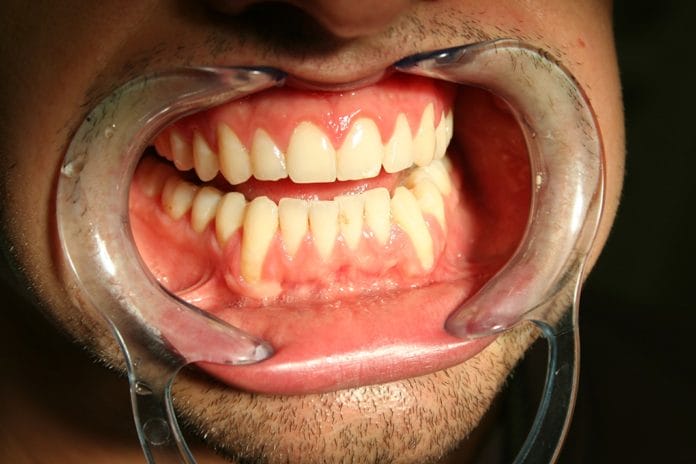Gingival recession is a common malady we see to some degree on nearly every patient that comes through the dental office. Perhaps recession is minimal from over-aggressive toothbrushing, and a gentle word of warning and modification of brushing technique using an extra soft toothbrush are all that is required to keep the recession at bay. Periodontal disease and bruxism can lead to gingival recession as well. Regardless of the cause, the advancement of gingival recession can make a person eventually appear “long-in-the-tooth” even if they do not have periodontal disease. The physical appearance of their receded gumline makes some people “camera shy” as they do not like the appearance of their smile. We all know how sensitive root exposure can be, and sometimes down-right painful. The fact is, root exposure put our patients at high risk for caries and furcation involvement as well.
When it is obvious that the gingival margin has migrated apically from periodontal disease, we are gung-ho to treat the disease and desensitize the roots. The treatment for root exposure (whether mechanically or periodontally induced) has traditionally involved surgically invasive, painful grafting procedures that take weeks to recover from. Most patients simply feel it is not worth the pain of such a procedure where tissue may be grafted from their palate to be relocated as needed. I must admit, I rarely refer for such reasons, as I myself would not particularly like to have such a surgical procedure performed on me.
Recently, I had a patient in my chair who presented with generalized, moderate gingival recession and told us that he was saving his money to have the pinhole technique procedure. I have to admit, I had heard of the technique, but did not really know what was involved. That evening I went home and researched the procedure and was impressed with my findings. (I am a little ashamed that I did not know more about this procedure until said patient brought it to my attention.)
About the Pinhole Surgical Technique
The pinhole surgical technique (PST) was invented and developed by Dr. John Chao, DDS, MAGD. The PST is an innovative and minimally invasive procedure to treat gingival recession in a matter of minutes. A full arch can be treated in just under an hour. It is literally scalpel-free, suture-free, and graft-free and requires a minimally invasive pinhole (window) at the gingival buccal mucosa for the treatment of two-to-three teeth, and the results are immediate. Imagine arriving at the dental office looking “long-in-the-teeth” and leaving an hour later with a beautiful gumline that makes you want to smile. This procedure could be considered a cosmetic “face-lift” of sorts for those who are plagued with advanced gingival recession. It can be life-changing by bringing happiness and confidence in their appearance.
Initially, the roots and sulcus will be debrided, and caries, restoration surface irregularities, and root convexities are removed1 (smaller composites placed if needed after PST is completed). To begin the procedure, a 2-3mm horizontal incision is made in the alveolar mucosa near the base of the vestibule. Instruments specially designed by Dr. Chao are inserted in the opening where the gum tissue is gently loosened (released) at the buccal and papillae, creating a flap, and pulled over the receded areas. Collagen strips are then placed between papillae and along the buccal to hold the flap in place instead of sutures.1 Collagen strips plump up the buccal and stabilize the tissue throughout the healing process. The circumferential fibers work like a rubber band to keep collagen in. The results are dramatic and immediate.
Post-operative pain is minimal and requires on average 1-2 OTC pain pills, ice, and rest. Since the blood supply is not cut during the procedure, patients heal at a much faster rate than grafting or coronal flap surgeries. Mean level of patient esthetic satisfaction is 95.1% which makes this a procedure worth recommending.1 Class I or II root defects result in 100% root coverage 81.2% of the time.1 All Periodontists who perform this procedure are trained at Dr. Chao’s Pinhole Academy, and it is worth checking around to discover which periodontists in your area may be a good referral source.
In some instances, bone regeneration around an implant can also be attained after pinhole procedure. Black triangles between teeth (lack of papillae) have also been known to regenerate in some cases, not all, but some, after pinhole procedures. To date, Dr. Chao’s longest successful case is 16 years post-PST. There are no pseudo-pockets after surgery, as there is attached tissue after PST.
What Hygienists Need to Know
Who is a candidate for PST?
Anyone experiencing receding gums may be a candidate for pinhole surgery; however, your referring PST periodontist (after an initial and thorough one-on-one evaluation) will determine if the procedure is right for your patient. Ideally, the candidate should be healthy, periodontally stable from disease, decay, and failing restorations, have adequate attached gingivae (2-3mm), a non-smoker, and free of diabetes or an autoimmune disorder, as these conditions lessen and/or prevent healing times.
When should a dental hygienist recommend this procedure?
1) If gingival recession is sensitive to cold temperatures and does not respond to desensitizing agents or fluorides
2) Recession that visually hampers the patient’s self-confidence (appearance)
3) If a patient’s periodontal disease is well-managed
4) If recession is caused by over-aggressive toothbrushing, the patient must have reformed their method of brushing to avoid re-receding the tissue
Overall, this procedure should be suggested if the patient brings the concern to the table and doesn’t want traditional surgical intervention.
What are contraindications for PST?
Contraindications for PST include non-compliant homecare, less than 2-3mm attached gingiva, compromised immune system, smoker, teeth grinding or malocclusion, rampant active decay or periodontal disease, and/or class 5 restorations.
What are the oral hygiene instructions after the procedure?
Dr. Chao recommends NO brushing for six weeks in the area of treatment. Patients should be seen the next day after the procedure for an immediate follow-up to check healing time, then again a week later, then 3 and six weeks with debridement as necessary. After the 6th week, Dr. Chao instructs patients of the Roll-Method of brushing with an extra soft toothbrush.
Patients are to be re-assessed every 3 to 6 months based on their individual needs as recommended by the periodontist doing the procedure.1. I have not found any information on interproximal cleaning or periodontal probing recommendations post-PST; however, I am sure the acting periodontist would keep a close line of communication going with the general dentist to advise on recommended protocol for probing and interproximal care.
When to refer back to the periodontist?
Just like any other procedure, please refer back to the periodontist if the patient notices any discomfort, swelling, inflammation, bleeding, or if further recession or pocketing is noted. (Again, only probe after the periodontist advises that it is permissible.)
How long will PST last?
According to Dr. Chao, PST is expected to be permanent. However, nothing lasts forever because of the normal aging process. If patients do not over-scrub and continue to keep a healthy mouth, their PST should last a very long time.
Not all Periodontists Support the Pinhole Surgical Technique
Your referring periodontist may not support PST treatment. For instance, they may feel it is a procedure that seems like a shot in the dark with no real guidance, a guessing game of sorts. Think of liposuction. Watch a few PST procedures online, and you will understand. If I decided to have my gingival recession addressed, I would personally consider a consultation with a certified PST periodontist and ask a LOT of questions!
It is important to feel confident referring to a periodontist who has plenty of training and experience performing the PST with a high rate of success. This may require you to interview your referring periodontists to see who does the PST procedure, and who does it with confidence and success, as most periodontists still believe in surgical grafting as the standard of care for treating gingival recession.
In closing
Generally speaking, as dental hygienists, we spend the most time with patients and are often asked about restorative and surgical procedures, even though we don’t provide the treatment directly. Because of this, we must be knowledgable to answer patient questions and know when to refer for such procedures, such as the pinhole surgical technique.
Reference
- Chao J. A novel approach to root coverage: The pinhole surgical technique. The International Journal of Periodontics and Restorative Dentistry. 2012; 32(5): 521-530.











